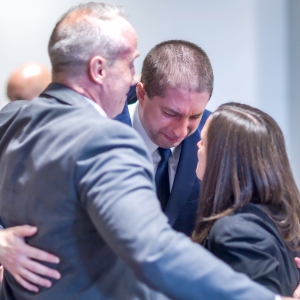Role of radiation therapy and nurse navigators in cancer diagnoses
| Published: 12-13-2022 10:19 AM |
Dr. Kristofer Roberts, MD, and nurse navigators Caitlin Roberts, BSN, RN, OCN, and Kim Pauliks, BSN, RN, of Concord Hospital Payson Center for Cancer Care discuss radiation oncology and navigating a cancer diagnosis.
Radiation therapy (RT) is a specific type of cancer treatment used alone or in conjunction with other therapies. It involves delivering varying doses of radiation to a desired target, while minimizing exposure to the surrounding healthy tissue. RT works by damaging the DNA of cells and destroys their ability to reproduce. Both normal cells and cancer cells can be affected by radiation but cancer cells have a generally impaired ability to repair the damage. We tailor treatments to exploit this difference from normal cells. Ensuring six or more hours between treatments allows the normal cells to repair some damage, keeping toxicity as low as possible while still killing the cancer cells. RT is what is known as a local therapy and is more akin to surgery than immunotherapy or chemotherapy, which are systemic.
Radiation can be administered in a few different ways, the most common of which is external beam radiation therapy (EBRT), which delivers radiation from the outside of the body. Brachytherapy, which has been available the longest, is radiation delivered from inside the body by permanently or temporarily implanting sources of radiation. Higher doses of radiation can be delivered in this manner; however, it involves the risks of anesthesia, infection, and bleeding, among others that are not a challenge with the minimally invasive EBRT.
Image guidance has drastically improved over the last few decades enabling us to reduce the margin around the target area and lower the risks of toxicity for patients. Daily non-diagnostic CT scans, for example, allow us to assess shifts in the soft tissue anatomy, which can vary from day to day. Another technology is called an optical surface monitoring system (OSMS), which monitors a patient’s movements during RT. This technique allows us to monitor and manage motion in real time with sub- millimeter accuracy. OSMS enables immediate radiation shut-off if a small shift in the patient’s position is outside pre-determined tolerance levels leading to less risk of toxicity and optimized targeting.
Cancer care is quite complex and comprehensive on both the provider side as well as the patient side. Oncology nurse navigators help cancer patients navigate the increasingly complicated healthcare system from pre-diagnosis/consultation and through diagnosis, treatment, and end-of-life care or survivorship. As many specialties are a part of cancer care, oncology nurse navigators achieve this by establishing and fostering communication and collaboration across the healthcare team as a whole. First and foremost, oncology nurse navigators assess and address barriers to care, such as a lack of health insurance, other health issues, or homelessness. Nurse navigation roles continue to evolve to improve transitions, access, patient experience, and quality cancer care.
Though medicine continues to improve, cancer is still a very prevalent and difficult diagnosis for many around the world. Every year the American Cancer Society puts out numbers and statistics regarding the prevalence in the United States. The numbers for this year indicate that prostate and breast cancers are still the most common in men and women, respectively; however, lung cancer continues to be the leading cause of cancer death for both. New Hampshire alone is expected to have over 9,000 newly diagnosed cancer cases in 2022.
Dr. Kristofer Roberts and oncology nurse navigators Caitlin Roberts and Kim Pauliks of Concord Hospital Payson Center for Cancer Care spoke about navigating a cancer diagnosis and the role radiation therapy can play at the August Concord Hospital Trust “What’s Up Doc?” Donor Lecture Series. The monthly series, supported by the Walker Lecture Fund, features members of Concord Hospital’s medical staff speaking to Concord Hospital Trust donors about new and innovative medical treatments and services. You can watch the group’s presentation on Concord Hospital’s YouTube channel at: youtube.com/concordhospital.
]]>
Article continues after...
Yesterday's Most Read Articles
 Bill to allow ‘no fault’ evictions makes it to governor’s desk
Bill to allow ‘no fault’ evictions makes it to governor’s desk
 ‘He’s coming home’: Jury acquits former prison guard Matthew Millar in murder trial
‘He’s coming home’: Jury acquits former prison guard Matthew Millar in murder trial
 Look, up in the sky! It’s… an Airstream trailer?
Look, up in the sky! It’s… an Airstream trailer?
 Around Concord: Living in an 1856 schoolhouse is (mostly) delightful
Around Concord: Living in an 1856 schoolhouse is (mostly) delightful
 Slots and no bet limits: State budget shakes up New Hampshire’s casino landscape
Slots and no bet limits: State budget shakes up New Hampshire’s casino landscape
 ‘Deep flavor’ – New restaurant in downtown Concord offers creative spin on comfort food and cocktails
‘Deep flavor’ – New restaurant in downtown Concord offers creative spin on comfort food and cocktails







 Around Concord: Refreshing recipes from Table Bakery
Around Concord: Refreshing recipes from Table Bakery The Rebel Collective to perform in Henniker
The Rebel Collective to perform in Henniker Meet Moriah Billups, Young Professional of the Year
Meet Moriah Billups, Young Professional of the Year Artist spotlight: Leah Kuehne
Artist spotlight: Leah Kuehne
